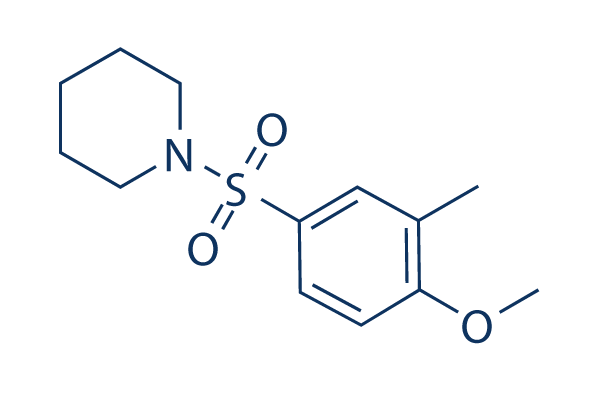| Cas No.: | 457961-34-1 |
| Chemical Name: | AA92593 |
| Synonyms: | AA92593;AA-92593;AA 92593 |
| SMILES: | O=S(N1CCCCC1)(C2=CC=C(OC)C(C)=C2)=O |
| Formula: | C13H19NO3S |
| M.Wt: | 269.36 |
| Purity: | >98% |
| Sotrage: | 2 years -20°C Powder, 2 weeks 4°C in DMSO, 6 months -80°C in DMSO |
| Description: | AA92593 is a selective and competitive OPN4 (melanopsin) antagonist[1][2]. |
| In Vivo: | AA92593 is able to decrease IOP in rabbits living under normal light condition[2]. AA92593 produces an increment in melatonin levels resulting in a drop of IOP[2]. Animal Model: Wild type (WT) mice[4]. Dosage: 30 mg/kg. Administration: IP 20 min prior to PLR measurement. Result: Attenuated pupil constriction in response to light (1013 ph.cm−2.s−1) by ~50%. |
| In Vitro: | AA92593 is a competitive melanopsin antagonist, its presence in the retinal-binding pocket of melanopsin leads to the displacement of retinal, which could trigger a downstream signaling that would ultimately result in Per1 increased expression[1]. AA92593 is shown to be specific because it competes with retinaldehyde for the melanopsin retinal binding site which is very distinct from other opsins[1]. Inhibition of melanopsin activity with AA92593 increases a-MSH expression and induces melanin dispersion in the melanophores, which darkens the embryo[3]. AA92593 exhibits an IC50 of 665 nM in CHOOpn4 cells[4]. Cell Viability Assay[1] Cell Line: Melan-a melanocytes and B16-F10 melanoma cells[1]. Concentration: 10 μM. Incubation Time: 1 hour (heat 39.5 °C). Result: Pharmacologically inhibited melanopsin. |
| References: | [1]. Maria Nathália Moraes, et al. Melanopsin, a Canonical Light Receptor, Mediates Thermal Activation of Clock Genes. Sci Rep. 2017 Oct 25;7(1):13977. [2]. Victoria Eugenia Lledó, et al. Yellow Filter Effect on Melatonin Secretion in the Eye: Role in IOP Regulation. Curr Eye Res. 2019 Jun;44(6):614-618. [3]. Gabriel E Bertolesi, et al. Melanopsin photoreception in the eye regulates light-induced skin colour changes through the production of α-MSH in the pituitary gland. Pigment Cell Melanoma Res. 2015 Sep;28(5):559-71. [4]. Kenneth A Jones, et al. Small-molecule antagonists of melanopsin-mediated phototransduction. Nat Chem Biol. 2013 Oct;9(10):630-5. |

 To enhance service speed and avoid tariff delays, we've opened a US warehouse. All US orders ship directly from our US facility.
To enhance service speed and avoid tariff delays, we've opened a US warehouse. All US orders ship directly from our US facility.




















